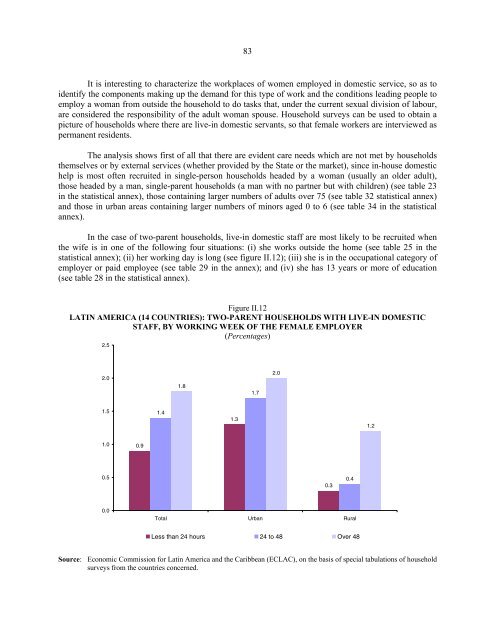Women in Latin America and the Caribbean - Cepal
Women in Latin America and the Caribbean - Cepal
Women in Latin America and the Caribbean - Cepal
Create successful ePaper yourself
Turn your PDF publications into a flip-book with our unique Google optimized e-Paper software.
83<br />
It is <strong>in</strong>terest<strong>in</strong>g to characterize <strong>the</strong> workplaces of women employed <strong>in</strong> domestic service, so as to<br />
identify <strong>the</strong> components mak<strong>in</strong>g up <strong>the</strong> dem<strong>and</strong> for this type of work <strong>and</strong> <strong>the</strong> conditions lead<strong>in</strong>g people to<br />
employ a woman from outside <strong>the</strong> household to do tasks that, under <strong>the</strong> current sexual division of labour,<br />
are considered <strong>the</strong> responsibility of <strong>the</strong> adult woman spouse. Household surveys can be used to obta<strong>in</strong> a<br />
picture of households where <strong>the</strong>re are live-<strong>in</strong> domestic servants, so that female workers are <strong>in</strong>terviewed as<br />
permanent residents.<br />
The analysis shows first of all that <strong>the</strong>re are evident care needs which are not met by households<br />
<strong>the</strong>mselves or by external services (whe<strong>the</strong>r provided by <strong>the</strong> State or <strong>the</strong> market), s<strong>in</strong>ce <strong>in</strong>-house domestic<br />
help is most often recruited <strong>in</strong> s<strong>in</strong>gle-person households headed by a woman (usually an older adult),<br />
those headed by a man, s<strong>in</strong>gle-parent households (a man with no partner but with children) (see table 23<br />
<strong>in</strong> <strong>the</strong> statistical annex), those conta<strong>in</strong><strong>in</strong>g larger numbers of adults over 75 (see table 32 statistical annex)<br />
<strong>and</strong> those <strong>in</strong> urban areas conta<strong>in</strong><strong>in</strong>g larger numbers of m<strong>in</strong>ors aged 0 to 6 (see table 34 <strong>in</strong> <strong>the</strong> statistical<br />
annex).<br />
In <strong>the</strong> case of two-parent households, live-<strong>in</strong> domestic staff are most likely to be recruited when<br />
<strong>the</strong> wife is <strong>in</strong> one of <strong>the</strong> follow<strong>in</strong>g four situations: (i) she works outside <strong>the</strong> home (see table 25 <strong>in</strong> <strong>the</strong><br />
statistical annex); (ii) her work<strong>in</strong>g day is long (see figure II.12); (iii) she is <strong>in</strong> <strong>the</strong> occupational category of<br />
employer or paid employee (see table 29 <strong>in</strong> <strong>the</strong> annex); <strong>and</strong> (iv) she has 13 years or more of education<br />
(see table 28 <strong>in</strong> <strong>the</strong> statistical annex).<br />
Figure II.12<br />
LATIN AMERICA (14 COUNTRIES): TWO-PARENT HOUSEHOLDS WITH LIVE-IN DOMESTIC<br />
STAFF, BY WORKING WEEK OF THE FEMALE EMPLOYER<br />
(Percentages)<br />
2.5<br />
2.0<br />
1.8<br />
1.7<br />
2.0<br />
1.5<br />
1.4<br />
1.3<br />
1.2<br />
1.0<br />
0.9<br />
0.5<br />
0.3<br />
0.4<br />
0.0<br />
Total Urban Rural<br />
Less than 24 hours 24 to 48 Over 48<br />
Source: Economic Commission for Lat<strong>in</strong> <strong>America</strong> <strong>and</strong> <strong>the</strong> <strong>Caribbean</strong> (ECLAC), on <strong>the</strong> basis of special tabulations of household<br />
surveys from <strong>the</strong> countries concerned.











